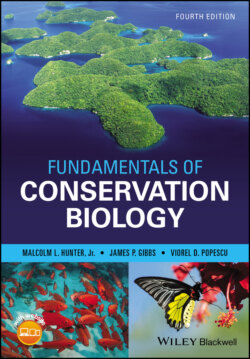Читать книгу Fundamentals of Conservation Biology - Malcolm L. Hunter Jr. - Страница 64
Ecological Values
ОглавлениеEvery population of every species is part of an ecosystem of interacting components, and thus has an ecological role to play. There are producers, consumers, decomposers, competitors, dispersers, pollinators, and more. In this sense, every species has ecological value, that is, instrumental use to other species that share the same ecosystem, including people.
Although all species have ecological roles, not all have roles of equal importance. Some species are ecologically important simply because of their great abundance. Often these are called dominant species, a term that usually implies that they constitute a large portion of the biomass of an ecosystem. Examples are sugar maples in a sugar maple forest or various species of planktonic copepods in many marine ecosystems. Sometimes, they are called controller species, which implies that they have major roles in controlling the movement of energy and nutrients. This would include dominant species such as sugar maples and various copepods, as well as many species of invertebrates, bacteria, and fungi that are important decomposers but may not have much biomass.
Some species play critical ecological roles that are of greater importance than we would predict from their abundance or biomass; these are called keystone species (Power et al. 1996). The classic example of a keystone species is the purple sea star, an intertidal predator that preys on several species of invertebrates, apparently allowing many species to coexist without any one species becoming dominant (Fig. 3.11). After these sea stars were experimentally removed from a rocky shore in the state of Washington, the population of one prey species, the California mussel, dominated the site, and the system shifted from 15 species of invertebrates and macroscopic algae to only eight species (Paine 1966). Most of the textbook cases of keystone species are animals. Some of them are predators like the sea star; some of them are “engineers” that create structures important to other species, such as the cavities of woodpeckers and burrows of tortoises that provide shelter for many species (Remm and Löhmus 2011) or the dams of beavers that create sizable new ecosystems and habitat for hundreds of other species and affect whole landscapes by trapping sediment and nutrients (Puttock et al. 2018) (Fig. 3.11). For an example of a keystone plant species, consider those species, like strangler figs, that produce abundant fruit during a season when only a few plant species bear fruit, making them a critical resource for all the obligate fruit‐eating animals (Shanahan et al. 2001; Watson 2001).
Figure 3.11 The ecological impacts of keystone species take many forms. The purple sea star (a) is a keystone species because its predatory activities allow many species to coexist, while beavers (b) shape entire communities because of flooding by their dams (c).
([a] Olympic National Park/Flickr/Public domain; [b] Hubert/Shutterstock. [c] Procy/Shutterstock)
As a rule, conservation biologists tend to focus more on the population health of keystone species than dominant or controller species because many keystone species are uncommon, whereas, by definition, dominant and controller species are relatively abundant. Of course, being abundant does not mean that these species are necessarily secure from population crashes. Many island plants have gone from being ecological dominants to being far less common following the introduction of exotic herbivores or competitors (Cole and Litton 2014). Even continental species have plunged from dominance to rarity in a short period; such was the case for the American chestnut (once 20% of the trees in eastern North America, now essentially gone) following invasion of an exotic fungus disease. Consequently conservationists should play close attention to all species that are highly interactive, both keystones and dominants, because changes in their populations affect entire ecosystems (Soulé et al. 2003). Indeed, some conservationists use the term “ecological extinction” if a species becomes too rare to fill its role in an ecosystem, a term that applies to many large animal species today (i.e. those that are still present but in greatly diminished numbers, like American bison).
When assessing the ecological roles of species, conservation biologists are typically conservative and assume every component of an ecosystem is important unless proven otherwise (Berlow 1999; Montoya et al. 2006). Our understanding of ecosystems is usually so limited that it is sensible to take this position, even though most species probably do not play irreplaceable roles. Furthermore, it is possible that one should look beyond the role of individual species because overall species richness of an ecosystem may be an important attribute. We will return to this issue in the next chapter, “Ecosystem Diversity.” Finally, it is important to realize that a species that is relatively unimportant now may become more important as an ecosystem changes through time. For example, since the last glaciation some trees species, such as eastern hemlock, have shifted between being ecosystem dominants over large areas and being quite uncommon (Williams et al. 2004).
Incidentally, there are many ways in which ecological values interface with economic values. Most notably, the health and productivity of people have huge economic consequences, and these are directly dependent on ecological integrity. One paper examined the relationship between deforestation by an invasive insect, the emerald ash borer, and human mortality, and suggested that through higher stress, lower air quality, and reduced physical exercise the insect might be linked to an increase of 20,000 deaths across 15 states in the United States (Donovan et al. 2013). Similarly, each species we use directly for economic gain as food, medicine, materials, and so forth depends on ecosystems and the continuing existence of a whole suite of other species.
